肺上叶与下叶社区获得性肺炎患者的临床特点及比较分析
葛 娟 陈永权 徐金富 陆海雯
程克斌2 梁 硕2
·论著·
肺上叶与下叶社区获得性肺炎患者的临床特点及比较分析
葛娟1陈永权1徐金富2陆海雯2
程克斌2梁硕2
社区获得性肺炎(community-acquired pneumonia, CAP)是一种常见的肺部疾病,它是指在医院外罹患的感染性肺实质(含肺泡壁,即广义上的肺间质)炎症,包括具有明确潜伏期的病原体感染而在入院后潜伏期内发病的肺炎[1-4]。由于解剖学和血流动力学的原因,CAP好发于肺中叶和下叶,但在临床工作中也经常会遇到上叶肺炎的患者。由于上叶CAP患者解剖部位不典型,经常会被误诊为肺结核或其它疾病。有关上叶CAP的临床特点以及与下叶CAP的区别,目前研究较少。本研究回顾性分析了197例上叶或下叶CAP患者的临床症状及实验室指标,探讨上叶与下叶CAP患者的临床特点,旨在增加对上叶CAP的了解,提高对肺上叶CAP的诊治水平。
资料与方法
一、一般资料
搜集2011年1月至2014年12月在上海市肺科医院住院的197例CAP患者的临床资料,其中下叶肺炎患者115例,平均年龄(52.87±16.46)岁,上叶肺炎患者82例,平均年龄(51.11±16.92)岁(P=0.448)。所有患者均符合中华医学会呼吸分会《社区获得性肺炎诊断及治疗指南》的标准,除外:①上叶、下叶均有病灶的患者;②肿瘤等引起的阻塞性肺炎;③病灶部位存在其他基础肺结构改变的疾病;④正在放化疗或粒细胞减少症者。另外,因部位划分的问题,本研究将右肺中叶、左肺上叶舌段肺炎也予以除外。
二、研究方法
根据胸部影像学检查,主要是胸部CT检查,将患者分为上叶肺炎组和下叶肺炎组。分别记录入选患者的姓名、性别、年龄、基础疾病、发病时的体温及咳嗽、咳痰、胸闷等临床症状,入院时的主要体检参数(体温、脉搏、呼吸频率、血压、意识状态等);实验室检查包括血白细胞计数、中性比例、血红蛋白、血小板、嗜碱性粒细胞计数、血细胞比容、血钠、血糖、血尿素氮、D-二聚体、C反应蛋白(C-reactionprotein, CRP)、血沉、血气分析、血清蛋白电泳、血白蛋白、CD4+、CD8+、IgG、IgM以及转铁蛋白、肿瘤坏死因子等;胸部影像学检查结果;以及入院后用药情况、预后转归。
三、统计学方法
采用SPSS19.0统计软件进行统计学分析。计量资料以mean±SD表示,呈正态分布的计量资料使用t检验;非正态分布使用非参数检验,P<0.05为差异有统计学意义。实验室数据以外的差异使用卡方检验。
结果
一、上叶肺炎与下叶肺炎患者的基础情况比较
1. 二组在性别组成,起病诱因及是否合并呼吸系统疾病上无统计学差异,见表1。上叶肺炎中约13例既往有过呼吸系统疾病史,一般为肺结核或慢性咳嗽病史;下叶肺炎组既往有肺部基础疾病的26例,除肺结核、慢性咳嗽外,部分有醉酒、慢性支气管炎、肺气肿、真菌感染病史。总体基础疾病二组间无明显差异。然而,上叶肺炎组有基础疾病的为41例,糖尿病4例;下叶肺炎组基础疾病为52例,其中糖尿病或存在糖耐量异常的17例。下叶肺炎组合并糖尿病患者明显增多,P<0.05,见图1。
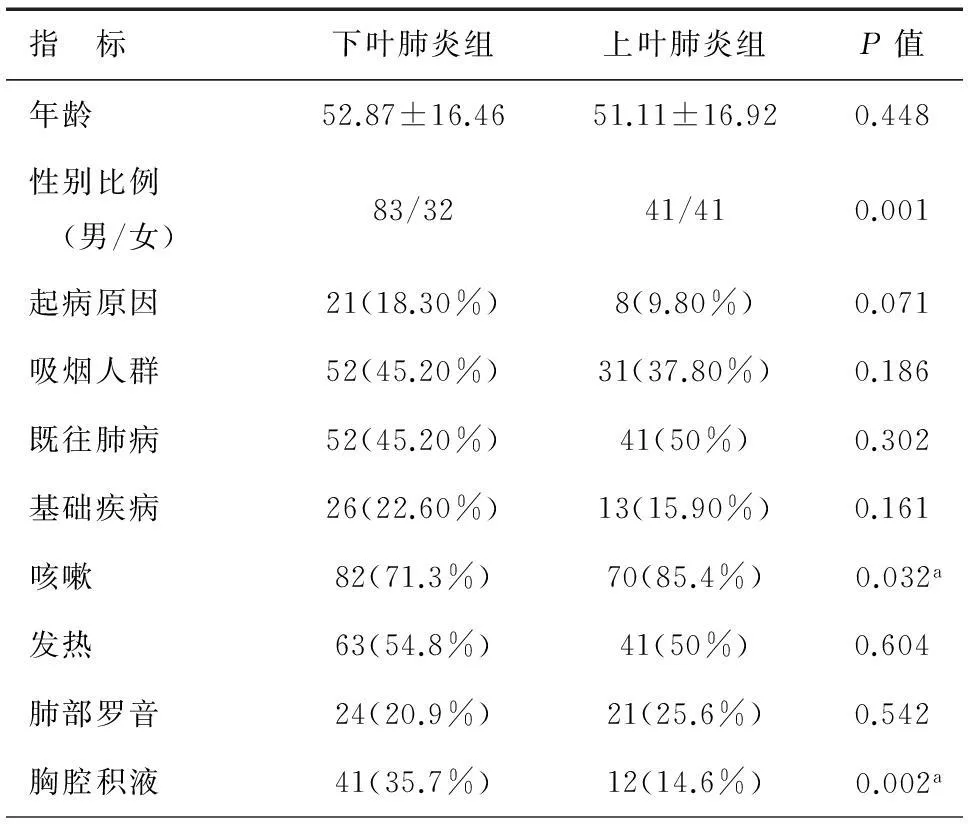
表1 二组患者一般情况及临床表现比较
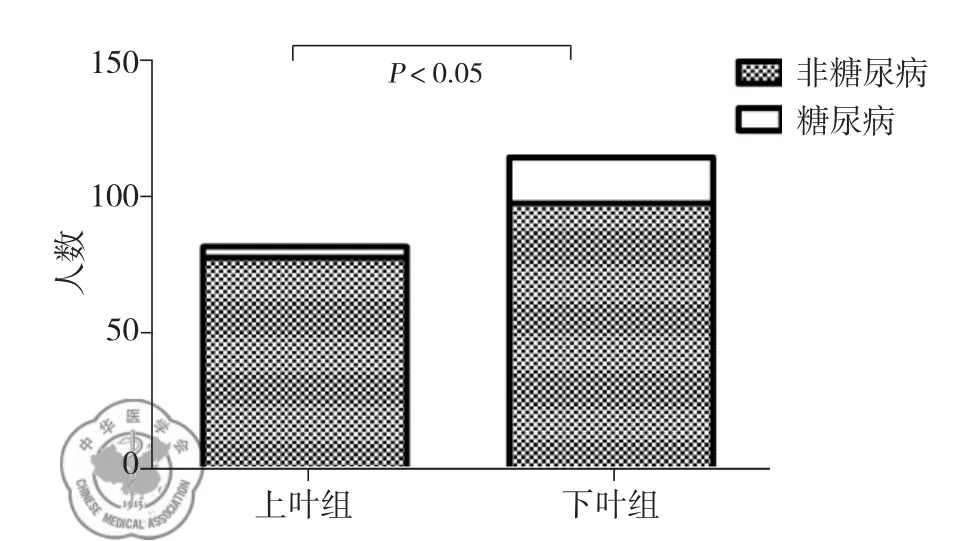
图1 二组间合并糖尿病患者情况比较
2. 在合并胸腔积液方面,上叶肺炎组有胸腔积液的21例,下叶肺炎组为63例。下叶肺炎组明显比例高于上叶肺炎组,P=0.002。
3. 发热方面,上叶肺炎组发热41例,40 ℃以上2例;下叶肺炎组发热63例,40 ℃以上11例。下叶组40 ℃以上发热比例明显高于上叶组。
4. 在咳嗽脓痰上,上叶肺炎组咳嗽患者70例,无咳嗽12例;下叶组咳嗽患者相对较多,脓痰患者的比例亦高于上叶肺炎患者。
二、上叶肺炎与下叶肺炎患者的实验室指标比较
二组患者动脉血气分析、血白细胞计数及中性粒细胞比例、肝肾功能、血沉,C反应蛋白等指标均无明显差异。但上叶肺炎组血IL-6水平、CD4+T细胞比值明显高于下叶CAP组,上叶肺炎组患者D-二聚体水平明显低于下叶肺炎组,见图2,3,4。
三、上叶肺炎与下叶肺炎患者的住院时间与预后
上叶肺炎组患者平均住院时间为(8.21±3.53)d,下叶肺炎组为(9.2±4.91)d;两组间比较无明显差异(P=0.263)。下叶肺炎组中有3例最终通过手术确诊,而上叶肺炎组中有5例通过手术确诊,从手术率来看,上叶肺炎组为多,分析考虑手术率高的原因与上叶肺炎长期治疗病灶吸收不理想,对诊断产生怀疑而行手术。这也间接提示上叶肺炎的诊断存在一定的困难。
讨论
社区获得性肺炎是一种常见的肺部疾病,发病率及病死率均较高,据统计全世界CAP发病率为18.2%。住院患者病死率为5%~15%[15-22]。所以社区获得性肺炎仍倍受临床工作者关注。通常社区获得性肺炎以下叶好发,上叶相对少见,但近年来,在临床工作中我们发现上叶社区获得性肺炎的比例似乎有所上升。
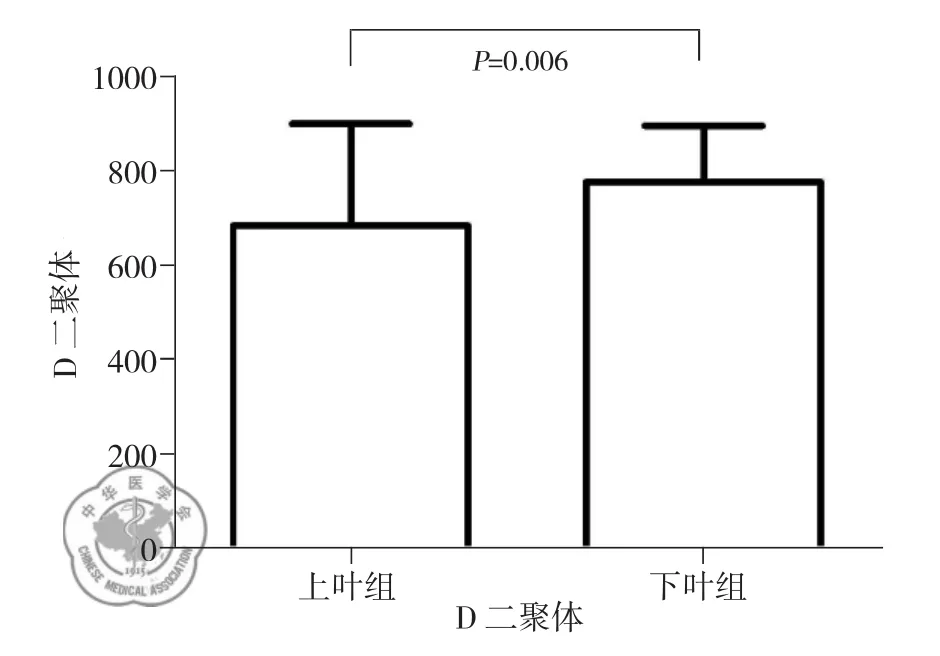
图2 二组间D二聚体的比较
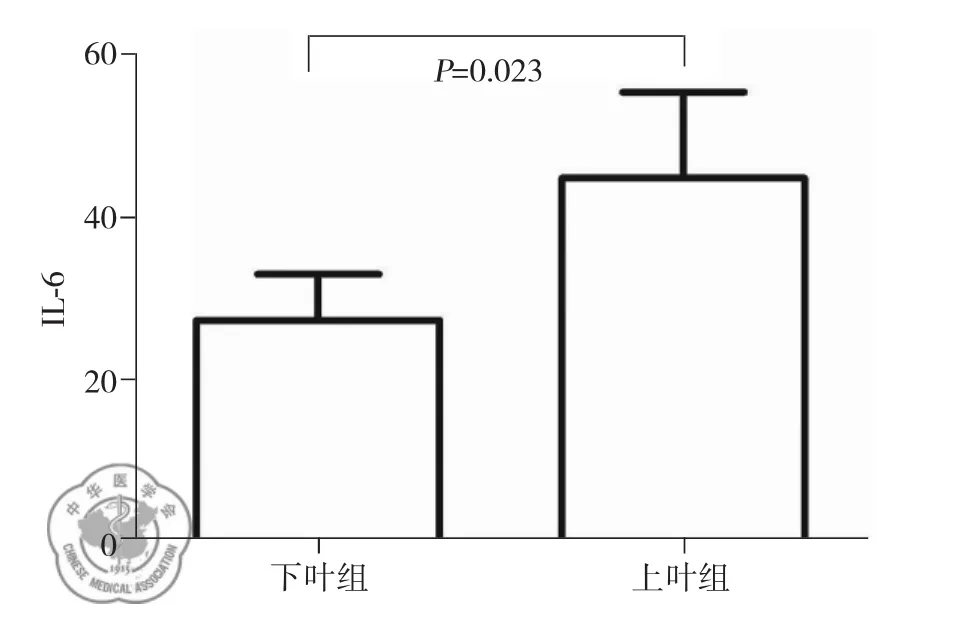
图3 二组间血IL-6水平的比较
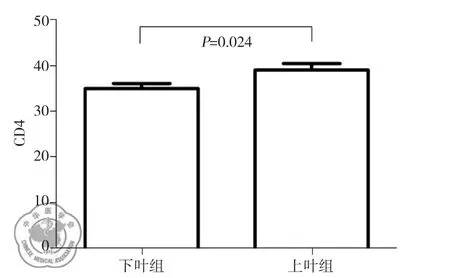
图4 二组间血CD4+T细胞比例的比较
本研究显示上叶肺炎男女比例相仿,以咳白痰为主,合并胸腔积液较下叶少,发热程度与下叶相仿,但40 ℃以上的超高热明显较下叶组少。提示上叶肺炎临床表现相对不明显。
D-二聚体是纤溶酶水解交联纤维蛋白降解后形成的特异性降解产物,是体内高凝状态和纤溶亢进的分子标志物之一。目前认为凝血/纤溶系统功能障碍在炎症发生、发展过程中具有重要作用。IL-6是一种具有广泛作用的多效应性细胞因子,主要由单核细胞与巨噬细胞产生。创伤、压迫、感染、脑死亡等多种因素所致急性炎症反应可迅速引起IL-6升高。它参与炎症的损伤过程,具有促进细胞生长、刺激急性时相蛋白合成的作用。有关社区获得性肺炎炎性指标变化的研究较多,而将上叶肺炎作为独立个体进行研究的较为少见。本研究显示上叶肺炎血IL-6、CD4+较下叶高,但D-二聚体较下叶低。提示上叶肺炎炎症刺激较为持久,而下叶肺炎患者相对免疫功能较低。
本研究显示上叶肺炎患者中右上叶肺炎52例,左上叶肺炎26例,双上叶为4例,右肺上叶占绝大多数。这可能与右肺上叶支气管解剖上的特点是右支气管与中线所成的角度较左侧小,借重力的作用可把受感染的物质吸入肺内有关。此外上叶炎症更多是否与咽喉部分泌物误吸也有一定关系。
在所选患者中痰液病原检出率较低,下叶肺炎中仅6例检及病原微生物,其中副流感嗜血杆菌两例,鲍曼不动杆菌、肺炎克雷伯菌、铜绿假单胞菌、表皮葡萄球菌各1例;上叶肺炎检及5例,其中嗜麦芽黄单胞菌3例,肺炎克雷伯菌1例,鲍曼不动杆菌1例。病原微生物获得较少,考虑与上海肺科医院收治的肺炎患者常已在外院就诊并使用抗生素经验性治疗有关。从已有数据看,下叶肺炎病原微生物种类较为丰富,而上叶肺炎以杆菌为主,甚至以非铜绿单胞菌为主。一般经验性治疗社区获得性肺炎主要针对G+球菌。从文献查阅中我们了解到无反应肺炎一般以G-菌为主[23],无反应肺炎患者血液及支气管肺泡灌洗液中IL-6增加[15],D-二聚体与病情严重程度呈正相关[24],故此推论在病程的相对早期时下叶肺炎症状较重,但上叶肺炎早期治疗失败的比例相对较高。同时根据上述结果,我们认为当上叶肺炎经验性治疗不顺利而病原学标本未获得时可考虑针对G-菌用药,甚至应联合应用喹诺酮类药物针对非铜绿的单胞菌治疗。当然,我们仍觉得加强痰液标本送检,提高病原微生物检出率是指导临床工作较为重要的一步。
资料表明,上叶的通气血流比例为3.3,下叶的通气血流比例为0.64,结合外科解剖情况,肺上叶血供较下叶为少。因此,上叶肺炎因局部血供不丰富,病灶局部炎症因子相对较少,抗生素局部沉积较少,导致治疗效果相对不佳,炎症控制时间更长,引起延迟吸收或不吸收。本组资料中上叶肺炎中有约17例患者通过长期随访及手术病理证实肺炎,比例较下叶肺炎组高。所以,我们认为上叶肺炎的治疗相对更为复杂持久,抗生素使用应该从重,甚至可适当延长治疗周期[14,23]。
本研究为回顾性分析,入选的病例数量较少,且较多一部分为老年人,基础疾病较多,不排除对结果有一定的影响。未来需要进一步扩大样本量的随机对照试验来验证。
参考文献
1陈恒屹, 崔社怀. 重症社区获得性肺炎病死率及预后分析[J/CD]. 中华肺部疾病杂志:电子版, 2010, 10(3): 322-335.
2刘元明, 王茂筠, 梁宗安. 血清降钙素原鉴别肺结核与社区获得性肺炎的价值[J]. 西部医学, 2014, 26(2): 166-168.
3徐利萍. 血清PCT和CRP检测在社区获得性细菌性肺炎中的应用价值[J]. 中国微生态学杂志, 2014, 26(1): 69-71.
4吴松, 肖秀林, 艾红梅. 血清PCT、IL-6和CRPP检测在社区获得性肺炎中的临床意义[J]. 国际检验医学杂志, 2014, 36(14): 1940-1941.
5Huang SL, Lee HC, Yu CW, et al. Value of procalcitonin in differentiating
pulmonary tuberculosis from other pulmonary infections: a meta-analysis[J]. Int J Tuberc Lung Dis, 2014, 18(4): 470-477.
for directing care among patients with non-severe community-acquired pneumonia[J]. Eur J Clin Microbiol Infect Dis, 2012, 31(12): 3397-3405.
7Johansson N, Kalin M, Backman-Johansson C, et al. Procalcitonin levels in community-acquired pneumonia-correlationwith aetiology and severity[J]. Scand J Infect Dis, 2014, 46(11): 787-791.
8Niu WY, Wan YG, Li MY, et al. The diagnostic value of serum procalcitonin, IL-10 and C-reactive protein in community acquired pneumonia and tuberculosi[J]. Eur Rev Med Pharmacol Sci, 2013, 17(24): 3329-3333.
9Bello S, Mincholé E, Fandos S, et al. Inflammatory response in mixed viral-bacterial community-acquired pneumonia[J]. BMC Pulm Med, 2014 , 14: 123.
10Tamura M, Watanabe M, Nakajima A, et al. Serial quantification of procalcitonin (PCT) predicts clinical outcome and prognosis in patients with community-acquired pneumonia (CAP)[J]. J Infect Chemother, 2014, 20(2): 97-103.
11Andrijevic I, Matijasevic J, Andrijevic L, et al. Interleukin-6 and procalcitonin as biomarkers in mortality prediction of hospitalized patients with community acquired pneumonia[J]. Ann Thorac Med, 2014, 9(3): 162-167.
12Sahin F, Yazar E, Yildiz P. Prominent features of platelet count, plateletcrit,mean platelet volume and platelet distribution width in pulmonary tuberculosis[J]. Multidiscip Respir Med, 2012, 7(1): 38.
13陈亮, 王玉梅. 社区获得性肺炎的影像学表现及临床意义[J]. 中国社区医师(医学专业), 2012, 14(10): 252-253.
14陈雪华. 社区获得性肺炎初始治疗无反应的原因和处理[J]. 中国实用内科杂志, 2014, 34(1): 96.
15Moret I, Lorenzo MJ, Sarria B, et al. Increased lung neutrophil apoptosis and inflammation resolution in nonresponding pneumonia[J]. Eur Respir J, 2011, 38(5): 1158-1164.
16Dorj G, Hendrie D, Parsons RW, et al. A questionnaire study of injections prescribed and dispensed for patients diagnosed with mild/moderate community-acquired pneumonia in Mongolia[J]. Peer J, 2015, 3: e1375.
17Marti C, Grosgurin O, Harbarth S, et al. Adjunctive Corticotherapy for Community Acquired Pneumonia: A Systematic Review and Meta-Analysis[J]. PLoS One, 2015, 10(12): e0144032.
18Loeb M. Community-acquired pneumonia: pneumococcal vaccine[J]. BMJ Clin Evid, 2015, pii: 1503.
19Ariza-Prota MA, Pando-Sandoval A, García-Clemente M, et al. Community-Acquired Pneumonia and Empyema Caused by in an Immunocompetent Patient[J]. Case Rep Pulmonol, 2015, 2015: 670373.
20Millett ER, De Stavola BL, Quint JK, et al. Risk factors for hospital admission in the 28 days following a community-acquired pneumoniadiagnosis in older adults, and their contribution to increasing hospitalisation rates over time: a cohort study[J]. BMJ Open, 2015, 5(12): e008737.
21Veni JK, Bhat G, Shalini SM, et al. Community-Acquired Methicillin Resistant Staphylococcus aureus Bacteremia: Case Series[J]. Kathmandu Univ Med J (KUMJ), 2015, 13(49): 77-79.
22In-iw S, Winijkul G, Sonjaipanich S, et al. Comparison between the Efficacy of Switch Therapy and Conventional Therapy in PediatricCommunity-Acquired Pneumonia[J]. J Med Assoc Thai, 2015, 98(9): 858-863.
23叶伟. 无反应肺炎的临床分析[D]. 大连医科大学, 2012.
24沈健, 朱一川, 徐太静, 等. D-二聚体、C 反应蛋白、降钙素原水平与老年社区获得性肺炎严重程度及预后的关系[J]. 中国当代医药, 2013, 20(3): 9-11.
(本文编辑:王亚南)
葛娟,陈永权,徐金富,等. 肺上叶与下叶社区获得性肺炎患者的临床特点及比较分析[J/CD]. 中华肺部疾病杂志: 电子版, 2015, 8(6): 734-738.
【摘要】目的探讨上叶社区获得性肺炎(CAP)与下叶CAP患者的临床特点。方法采用回顾性分析方法,选择2011年1月至2014年12月期间在上海市肺科医院住院的197例上叶或下叶社区获得性肺炎患者为研究对象,详细收集并整理患者的病史资料,分析上述患者的临床表现、影像学特点、实验室检查,伴发疾病及治疗上的特点,比较上叶CAP与下叶CAP的区别,更进一步了解上叶社区获得性肺炎的临床特点。结果上叶社区获得性肺炎组患者男女比例相仿,下叶CAP组男性为多。上叶社区获得性肺炎组咳嗽患者70/82例,无咳嗽12/82例,以白痰为主;下叶组咳嗽患者相对较多,脓痰患者的比例亦高于上叶肺炎患者。合并胸腔积液较下叶CAP少,上叶社区获得性肺炎组合并胸腔积液的有21/82例,下叶CAP组为63/115例;合并发热比例较下叶相仿,但40 ℃以上的超高热明显较下叶组少,统计显示上叶肺炎组发热41/82例,40 ℃以上2/82例;下叶肺炎组发热63/115例,40 ℃以上11/115例;血白介素6较下叶高,但D-二聚体均值较下叶组低,差异均有统计学意义(P<0.05)。结论上叶CAP临床表现常常不典型, 但炎症刺激更为持久,治疗相对更为复杂,抗生素使用应该从重,所需治疗疗程相对较长。
【关键词】社区获得性肺炎;上叶肺炎;下叶肺炎;临床表现;治疗
Clinical characteristics and comparative analysis of community acquired pneumonia in patients with upper and lower lobesGeJuan,ChenYongquan,XuJinfu,LuHaiwen,ChengKebin,LiangShuo.Departmentofrespiratory,No.6People′sHospital,Nantong226011,China;Departmentofrespiratory,ShanghaiPulmonaryHospital,Shanghai200433,China
Correspondingauthor:XuJinfu,Email: 13321922898@163.com
【Abstract】ObjectiveTo compare the clinical characteristics between upper lobe community-acquired pneumonia (CAP) and lower lobe CAP. Methods197 inpatients confirmed CAP in Shanghai Pulmonary Hospital From January 2011 to November 2014 were enrolled. We retrospectively reviewed the medical records of the clinical manifestations, imaging features, laboratory data, complications and treatments. The differences between upper lobe CAP and low lobe CAP were compared. ResultsThe male/female ratio of patients with community-acquired pneumonia in the upper lobes was equal,but men The male/female ratio of patients with community-acquired pneumonia in the upper lobes was equalwere the majority in lower lobe group pneumonia. The patients with white sputum were 70/82 and 12/82 patients had no cough in lower lobe group. Lower lobe pneumonia patients with cough and phlegm were more than the upper lobe pneumonia patients. However, the patients with the upper lobe pneumonia complicated with pleural effusion were fewer compared with patients with the lower lobe pneumonia (the upper lobe 21/82 cases, the lower lobe 63/115 cases). The number of patients with fever was similar in two groups, while the patients with high temperature (more than 40 ℃) are fewer in upper lobe pneumonia.The upper lobe pneumonia patients with fever were 41/82 cases, while 2/82 cases were more than 40 ℃. Likewise, the upper lobe pneumonia patients were 63/115 cases, and 11/115 were cases; Moreover, the level of serum interleukin-6 and CD4 were higher in upper lobe pneumonia than that in the lower lobe pneumonia, but the level of serum D-dimmer was lower,the difference was statistically significant(P<0.05). ConclusionsThe clinical features of CAP in the upper lobes are often atypical, with more enduring inflammation stimulation and relatively more complicated treatment. Consequently, this type of patients should be given relatively large doses of antibiotics and long treatment course.
【Key words】Community-acquired pneumonia;Upper lobe pneumonia;Lower lobe pneumonia;Clinical manifestations
(收稿日期:2015-08-26)
中图法分类号:R563
文献标识码:A
通讯作者:徐金富,Email: 13321922898@163.com
基金项目:2015年度青年医学人才科研基金课题(WQ2015060)
作者单位: 226011 江苏省南通市第六人民医院呼吸内科`1
200433 上海市肺科医院呼吸二科`2
DOI:10.3877/cma.j.issn.1674-6902.2015.06.013

